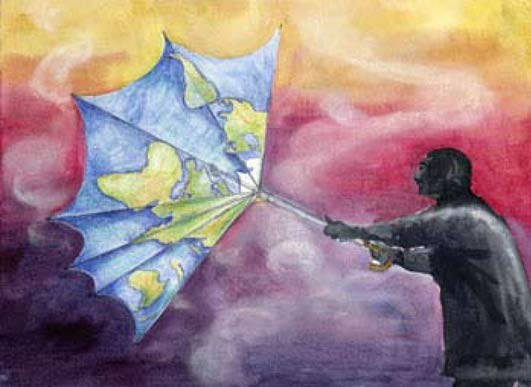Mid-summer’s nightmare as heat and fire together in a deadly, dangerous mix — in California, the McKinney fire near the Oregon border has burned 56,000 acres and killed four people so far, further north in Washington and Oregeon, a massive heat wave which killed more than a dozen recedes a bit up there to move and inflame the rest of the country with record temperatures.
All exacerbated by climate change.
In that regard, I spied this article yesterday and was going to post about it, but never got around to it — way-too much shit happening.
Climate change needs to be viewed as serious, and humanity informed of this serious shit happening with our environment and the ultimate consequences if the needed action isn’t taken — and soon::
New paper with PNAS just released. Climate Endgame: Exploring Catastrophic Climate Change Scenarios- https://t.co/GCuLqr1Taw We outline why catastrophic climate risks are underexplored, why they are critical, why they are plausible, and how to study them. A short overview thread!
— Luke Kemp (@LukaKemp) August 2, 2022
Serious questions about the seriousness of a serious subject — from the Guardian:
“There are plenty of reasons to believe climate change could become catastrophic, even at modest levels of warming,” said Dr Luke Kemp at the University of Cambridge’s Centre for the Study of Existential Risk, who led the analysis.
“Climate change has played a role in every mass extinction event. It has helped fell empires and shaped history.
“Paths to disaster are not limited to the direct impacts of high temperatures, such as extreme weather events. Knock-on effects such as financial crises, conflict and new disease outbreaks could trigger other calamities.”The analysis is published in the journal Proceedings of the National Academy of Sciences and was reviewed by a dozen scientists. It argues that the consequences of global heating beyond 3C have been underexamined, with few quantitative estimates of the total impacts.
“We know least about the scenarios that matter most,” Kemp said.A thorough risk assessment would consider how risks spread, interacted and amplified, but had not been attempted, the scientists said.
“Yet this is how risk unfolds in the real world,” they said.
“For example, a cyclone destroys electrical infrastructure, leaving a population vulnerable to an ensuing deadly heatwave.”
The Covid pandemic underlined the need to examine rare but high-impact global risks, they added.Particularly concerning are tipping points, where a small rise in global temperature results in a big change in the climate, such as huge carbon emissions from an Amazon rainforest suffering major droughts and fires. Tipping points could trigger others in a cascade and some remained little studied, they said, such as the abrupt loss of stratocumulus cloud decks that could cause an additional 8C of global warming.
The researchers warn that climate breakdown could exacerbate or trigger other catastrophic risks, such as international wars or infectious disease pandemics, and worsen existing vulnerabilities such as poverty, crop failures and lack of water.
The analysis suggests superpowers may one day fight over geoengineering plans to reflect sunlight or the right to emit carbon.“There is a striking overlap between currently vulnerable states and future areas of extreme warming,” the scientists said. “If current political fragility does not improve significantly in the coming decades, then a belt of instability with potentially serious ramifications could occur.”
There were further good reasons to be concerned about the potential of a global climate catastrophe, the scientists said: “There are warnings from history. Climate change has played a role in the collapse or transformation of numerous previous societies and in each of the five mass extinction events in Earth’s history.”
…
“Such temperatures currently affect around 30 million people in the Sahara and Gulf Coast,” said Chi Xu, at Nanjing University in China, who was part of the team.
“By 2070, these temperatures and the social and political consequences will directly affect two nuclear powers, and seven maximum containment laboratories housing the most dangerous pathogens. There is serious potential for disastrous knock-on effects.”…
“The more we learn about how our planet functions, the greater the reason for concern,” said Prof Johan Rockström, at the Potsdam Institute for Climate Impact Research in Germany.
“We increasingly understand that our planet is a more sophisticated and fragile organism. We must do the maths of disaster in order to avoid it.”
Nasty, scarey shit.
We’re being sucked into an E.L.E. slow-heating on top of us:
And even with the wondrously perplexed Téa Leoni suspended in time, here we are once again…
 (Illustration out front from the UN’s International Children’s Painting Competition, and found here.)
(Illustration out front from the UN’s International Children’s Painting Competition, and found here.)